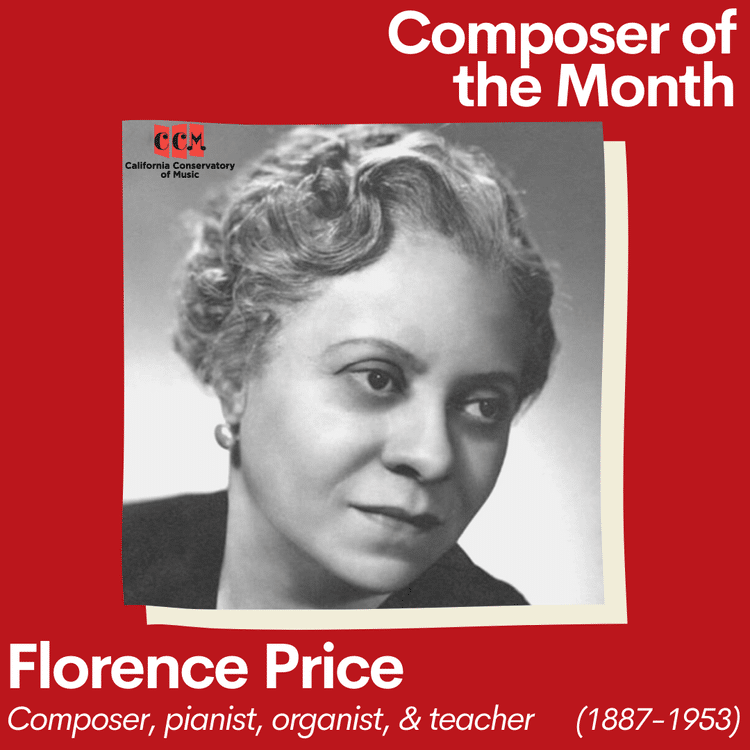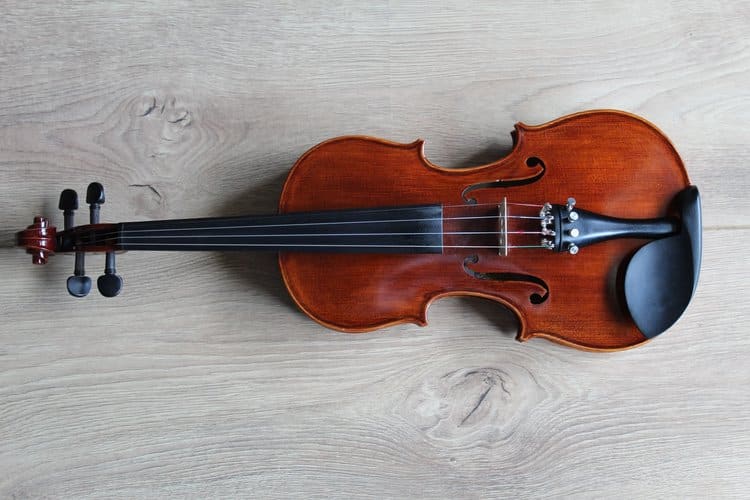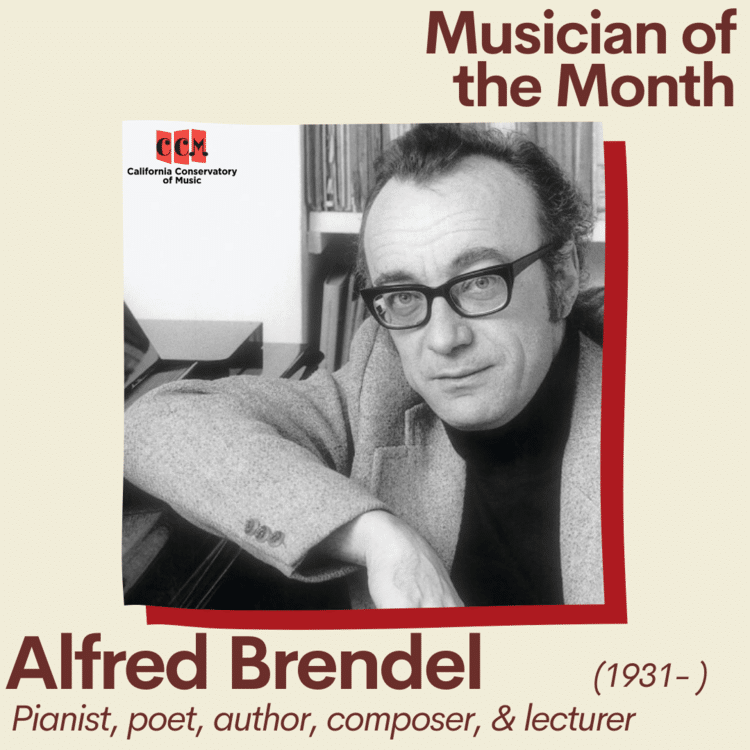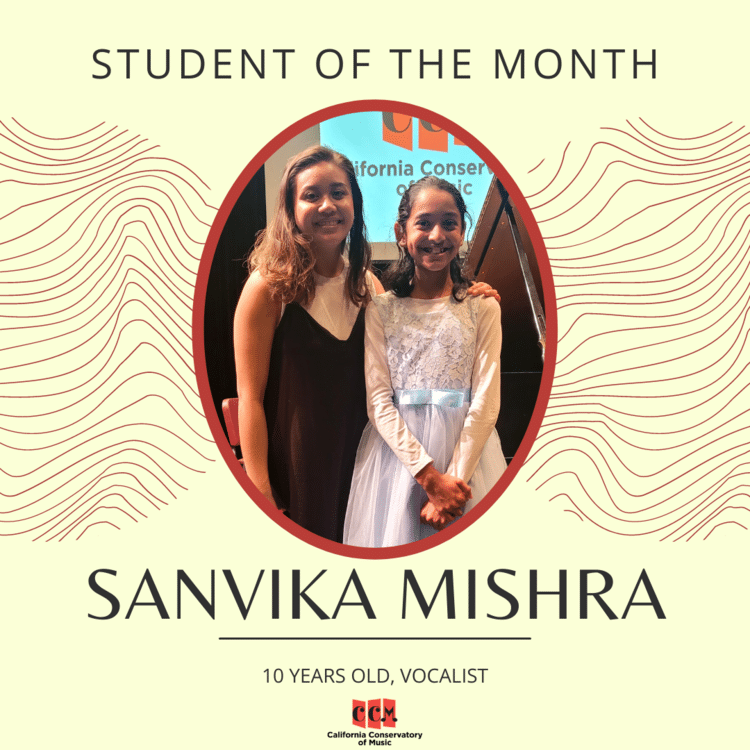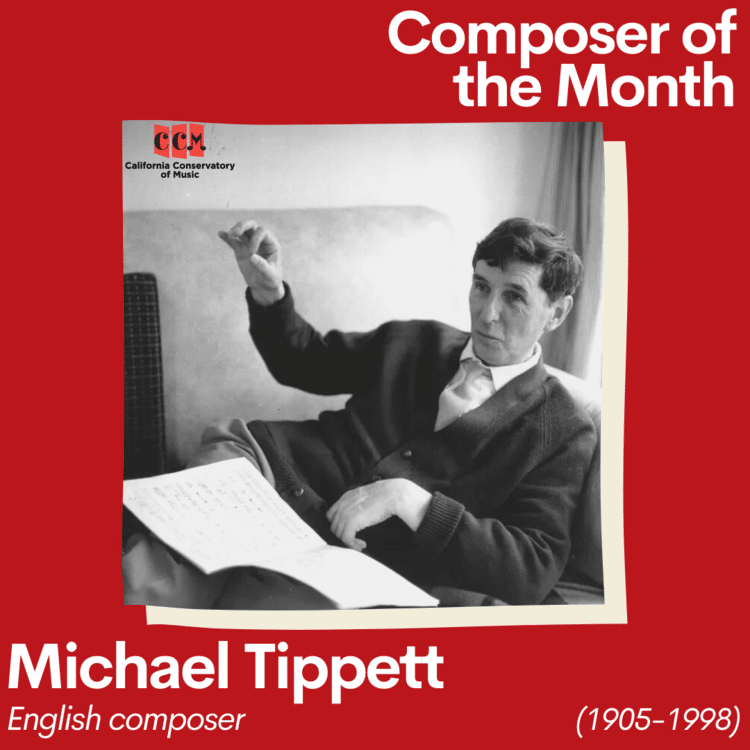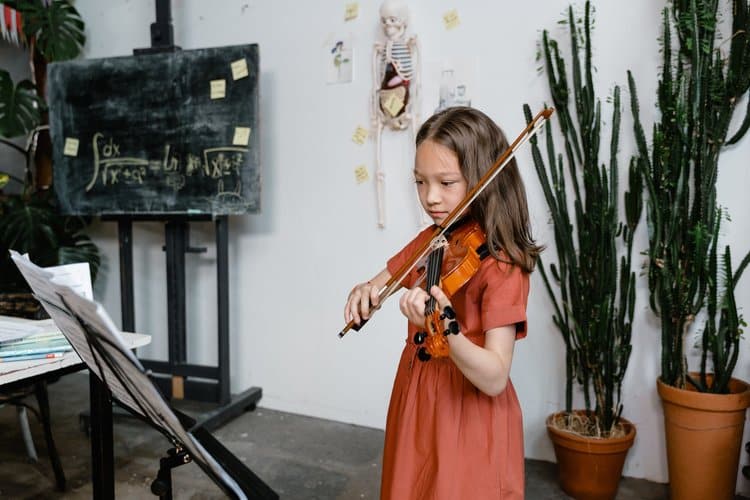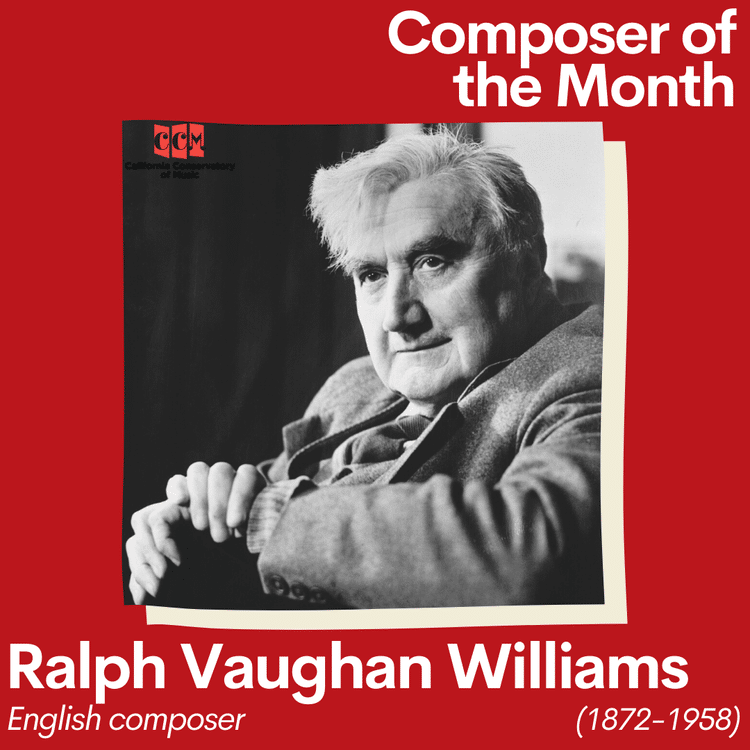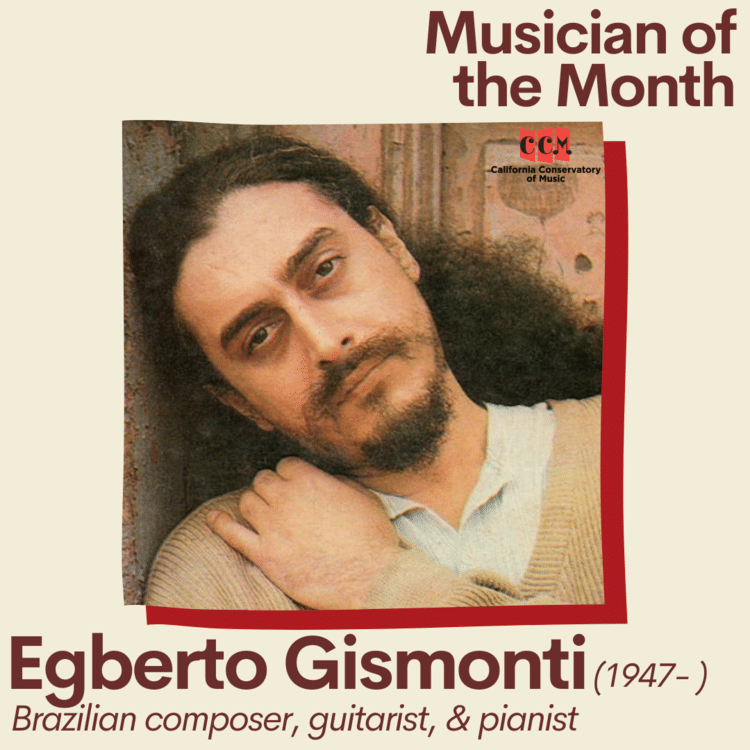One of the main purposes of our Composer of the Month initiative is to provide excellent opportunities for whole-community engagement and musical enlightenment around each month’s composer. Another reason is to lift and honor the work of music composers who have been previously excluded from the Western classical canon because of their gender, race, or both.
In honor of Black History Month, the California Conservatory of Music is celebrating the achievements and enduring legacy of Florence Price.
Florence Price’s Personal Life
Florence Beatrice Price was an American classical composer, organist, pianist, and music teacher. She was born in Little Rock, Arkansas, in 1887, where she took piano lessons and received a music education from her mother. This was because all the white music teachers in the area refused to take her on as a student.
Price lived in Little Rock, Arkansas until she left home in order to attend the New England Conservatory. It was one of the handfuls of conservatories that admitted African-American and Black students at the time.
It is worth noting that after graduation, Price returned to Little Rock, Arkansas, where she formally taught music and got married. She raised a family until the increasing dangers posed by racism and discrimination spurred Price and her family to move to Chicago.
Did you know that Florence Price is most well-known as the first Black woman to have her musical work performed by a notable American orchestra?
Life as a Composer
Impressively, Price composed more than 300 works. These works include symphonies, songs, and chamber works noted for their enchanting lyricism and lush orchestration. When she was 14, Price graduated as a high school valedictorian. Note that after two years, in 1903, she left Little Rock in order to attend the New England Conservatory of Music.
Keep in mind that in only 3 years at the conservatory, Price managed to gain a soloist’s diploma in organ as well as a teacher’s diploma in piano. Also, the principal, George Chadwick, encouraged and persuaded Price to compose, which turned out to be important and life-changing advice. Did you know that she took lessons in counterpoint and composition with famous composer Benjamin Cutter in her spare time?
In 1928, in order to escape growing racial discrimination and oppression in Little Rock, Arkansas, Price, and her family moved to Chicago. In Chicago, Price flourished creatively and won prizes as well as multiple publication contracts for her impressive piano pieces.
She also penned many popular songs for radio commercials and even arranged spirituals for performances. She then started writing symphonies in 1931.
Note that Price joined the famous R Nathaniel Dett Club of Music and the Allied Arts in order to make friendships with like-minded artists and musicians. She continued her composition studies at notable institutions, like the American Conservatory of Music, the University of Chicago, the Chicago Teachers College, and the Chicago Musical College.
Price’s career as a music composer catapulted to new heights after she moved to Chicago. In Chicago, she had developed several contacts while taking various summer courses and lessons at the Chicago Musical College.
Keep in mind that with the added support of some leading figures, especially within the Chicago Black Renaissance, such as Estelle Bonds, whose home was the principal gathering place for musicians and artists, Price’s works won many contests designed to support and help black composers.
The success of Price’s E Minor symphony helped cement her reputation and status, and many of her orchestral works were later performed by prominent ensembles. This is why students taking music lessons at the California Conservatory of Music are inspired by her work. To this day, Price’s compositions are an important part of Redwood City Music Lessons and Sunnyvale music lessons .
Some Notable Facts
- It was her move to Chicago that considerably expanded the music options available to Florence Price as a composer.
- Price studied with George Chadwick at the New England Conservatory.
- She wrote radio jingles and many popular songs besides her more serious compositions.
- Price was the only one of about 2,000 students to pursue a double-major in piano and organ.
- Price remained active and influential as a composer and music teacher until her death on June 9, 1953.
Many people know that the Italian luthier Andrea Amati developed the modern violin family in 1555. However, it is worth noting that various bowed-stringed musical instruments were invented before this date. It is helpful to consider the violin as an instrument that has gradually evolved over time instead of a perfected product that was invented instantaneously.
The elegant and traditional form of the violin may seem etched in stone as if this form has been a standard throughout history. However, the violin is a more recent invention compared to other instruments, though its creation was a slow and long process.
The Rebab and other Iterations
Did you know that one of the first recognizable ancestors of the modern violin is the Rebab? This instrument originated in the Middle East during the eighth century. You will also see the influence of the rebec (that emerged in Spain) and Arabian rabab in the modern violin.
The Rebab evolved with time in Europe into two separate and unique families of musical instruments: those that players held in their arms and were square-shaped (‘lira da braccio’) and those that players could position between their legs and had uniquely shaped sloped shoulders (‘lira da gamba’).
Both of these instruments had immense success; however, note that over time, the handheld instruments became more famous, leading to the development of the first violin in 1550.
The Emergence of the Violin
The violin emerged in 1550 in two Italian areas, Cremona and Brescia. While we don’t know who built the first violin, the first notable violin maker family in Cremona, Italy, was Amati. Later on the famous and excellent violin maker, Stradivarius, worked and lived in the same area. Even these days, most violins are developed following the design principles of Stradivarius.
The quality of violins made in Cremona led to the town being considered the home of the violin. Also, Cremona was home to the famous workshop of the notable Guarneri family of prolific instrument makers (Giovanni, Andrea, Giuseppe, and Bartolomeo.)
How has the Violin Changed Over the Years?
The violin has changed a little over time. For example, the earliest versions had only three strings. Violin makers added a fourth string in the middle of the 16th century. Did you know that all the violin strings were made from gut until about 1700?
After that, one string (the G String) with a silver wire was added in order to change the sound. However, nowadays all strings are a mixture of metal and nylon.
Note that the E string is often made of steel. In the eighteenth century, the violin underwent its most major and significant physical evolution. This was the change in the overall height of the bridge and extension of the neck and fingerboard. These changes ultimately improved the quality and volume of the sound.
The Violin Today
If you are interested in violin lessons, you probably know that the violin is one of the most popular musical instruments. Nowadays, violins are specially made so that they can produce high-quality sound electronically by using microphones and amplifiers, which eliminates the need for sound boxes.
Musicians use various amplifier settings to produce fully electric sounds. This sound can also be distorted in order to create different tonal qualities. It is no secret that the violin has gradually evolved to be a very valuable and versatile instrument.
Music Lessons and Education for Kids
As an inspiring violinist, your child should be aware of the violin’s predecessors, such as the Rebab, and how the violin carved its way into a prospering musical community already saturated with many instruments.
If your child is interested in violin lessons, you can start their musical journey with The California Conservatory of Music. Music education and lessons are important aspects of providing your children with a well-rounded education. Sunnyvale music lessons and Redwood City music lessons can provide developmentally appropriate music education for young children, introducing various concepts such as body movement, rhythm, and singing to preschoolers and toddlers.
Are you looking for violin lessons to help with the school orchestra? Note that students who sign up with the California Conservatory of Music will learn and become advanced and creative students and also benefit from improved discipline, friendships, and life skills.
Alfred Brendel is an Austrian author, poet and pianist, well-known for his contribution to the music industry. He is our musician of the month as he was born in January and possesses many talents and hobbies worth noting. He is an author and a poet and takes great interest in literature as well. His concerts and piano recordings established a very respectable image of his work amongst musicians and fans alike, securing him a spot in the list of the greatest musicians of the 20th and 21st centuries. Brendel is well-known for his masterpieces from Mozart to Beethoven and Brahms.
Early Life
Alfred Brendel was born on January 5, 1931, in Wiesenberg. He wasn’t born into a family that was very passionate about music, but that’s where his heart was.
Brendel got into music at a very early age when he started entertaining guests at his father’s hotel near the Adriatic coast where they had moved.
Later, his family shifted to a house in Zagreb and opened a cinema there. This was when his family started giving attention to the arts and music. This was also where Brendel began learning piano. At the age of eleven, he had practiced enough that it was evident he possessed a huge amount of talent.
He was self-taught for most of his early career as he never attended any piano lessons or music lessons. However, he eventually took some classes with Edwin Fischer and Eduard Steuermann.
He wrote and performed his piano music in 1948 when he was 17 years old. This was his first debut recital, which was held in Graz, The Fugue in Piano Literature. After Graz, his career as a pianist took off and his talent began getting vast recognition. Along with piano, he continued his other interests such as literature, painting, and composing.
Works Of Alfred Brendel
The popular Austrian musician and composer has a full catalogue of highly notable performances.
Often taking responsibility for the piece he was playing, Brendel’s performances were referred to as ‘cerebral’ by some critics. Interpretations of Beethoven, Mozart, and Haydn are notable performances of his.
Alfred Brendel was the first pianist to solo record a complete Beethoven sonata. He recorded the sonata and later went on to perform two more complete sonatas.
He also recorded several pieces from Mozart’s Great Piano Concertos and Schubert’s Last Three Piano Sonatas. His third record was Decca in which he recorded several of Beethoven’s sonatas as well as the works from Mozart and Mussorgsky.
Brendel was also well-known for international concerts and how much he had to offer from live performances. However, arthritis affected his concert performances, and he was forced to slow down on several demanding pieces.
Awards And Achievements
A survey in Limelight, rightfully ranked Brendel amongst the top ten greatest pianists of all time. He had a successful career that led him towards several awards and accolades, such as the Leonie Sonning Music Prize in 2002 and a Julliard Medal in 2011.
In 2009, a year after winning the Herbert von Karajan Music Prize, he was featured in a movie that went on to win several awards.
Brendel was also honored by being voted into Gramophone’s Hall of Fame in 2012, two years before he was given the golden Mozart medal.
Several well-known universities, including Yale, Oxford, Cambridge, and New York, awarded Brendel with honorary doctorates throughout his career.
Echo Klassik even gave Brendel a Lifetime Achievement Award in 2016 for his contribution to the music industry throughout the years.
Reach Out To Us
Alfred Brendel taught us that great things can be achieved in the music industry and you should keep yourself motivated to practice! Musicians like Brendel inspire us to pursue our dreams and make a notable, respected name for ourselves. If you’re a musician and would like to pursue your journey through the incredible language of music, contact us. The California Conservatory of Music, with the help of fantastic teachers and talented colleagues, can give you the tools to go as far in music as you are willing to work for. Reach out to us and schedule your music lessons and piano lessons today.
This month we are honored to feature CCM voice student, Sanvika Mishra, as our January 2022 Student of the Month! Sanvika has been taking voice lessons for around 6 months at CCM’s Sunnyvale location with Teacher Gaby. Teacher Gaby and the rest of us here at CCM have greatly enjoyed seeing Sanvika’s talents progress, especially at her amazing performance of Into the Unknown at our most recent winter recital! Congrats to Sanvika for her hard work and dedication!
Read below to see Sanvika’s great advice for CCM students just starting on their musical journey, and don’t forget to check out the parent spotlight as well.
Q: What is your name?
A: My name is Sanvika Mishra
Q: How old are you?
A: I am 10 years old.
Q: Who is your teacher?
A: Ms. Gaby is my teacher at CCM.
Q: What advice would you give to a voice student just starting out at CCM?
A: Practice everyday and enjoy while singing the songs. Teachers at CCM are very supportive and encouraging, and it helps the learning to be easy and fun.
Q: What song are you looking forward to learning/singing someday?\
A: I mostly enjoy singing Pop songs. But, I am looking forward to sing other genre songs as well. In recent days, I am interested to try the song Scars to Your Beautiful by Alessia Cara.
Q: What is your favorite thing about singing?
A: I love to improve my range, feel the song’s mood, and the favorite part is my performance.
Q: What is your favorite food?
A: One of my favorite food is butter chicken with naan. I also love some soups like miso soup.
Q: Do you have a pet?
A: No, I don’t have one. But I wish to have a pet in the future.
Q: Do you play any sports or do any other activities outside of music lessons?
A: I am also learning Kathak – an Indian classical dance form. I play tennis sometimes, but love the outdoor hiking, trail walks, camping the most.
Q: What do you want to be when you grow up?
A: I wish to be a singer and a Web designer.
Q: What is your most memorable experience at CCM?
A: My performance in CCM’s bi-annual recital is one of my favorite moments so far. I loved being performing there and it motivated me to perform even better in coming future.
……………………………………………………………………………………………………………………
Parent Spotlight – Sudhir Misra & Subhra S. Mahapatra
Q: Regarding voice instruction, what are you most proud of your child accomplishing?
A: We are happy that Sanvika enjoys and sings with confidence. She shows great interest in regular practice and rehearsals. We are proud of her commitment and sincerity in pursuing her dream to be a singer and a performer.
Q: What advice would you give a new parent starting in the program?
A: Listen to the music together with your kid, which they enjoy. Let them sing the songs they enjoy and love to sing, it motivates them to keep-up the enthusiasm in learning.
Q: Why did you decide to give your child a musical upbringing?
A: Both of us love music and songs. From an early age, Sanvika, too has shown inclination towards singing and music. We hope, she could accomplish her singing dreams and be successful in her musical journey.
California Conservatory of Music is continuing to celebrate Composer of the Month this month by honoring Michael Tippett, a prolific British composer, a humanitarian, and a pacifist. Did you know that the gamut of his work comprises four symphonies, five operas, and five-string quartets? He also wrote numerous songs, four piano sonatas, and amazing orchestral works, such as the Triple Concerto and several works for voices, which is fascinating.
Michael Tippett’s Personal Life
Sir Michael Tippett was born in 1905 in London and spent his childhood mainly in Suffolk. Tippett’s father had retired and had purchased a hotel in France. Tippett went to school in Edinburgh at the age of 13, but he didn’t like it there. This is why he attended the local Stamford Grammar School located in Lincolnshire.
It is worth noting that Tippett studied music at the Royal School of Music. Disillusioned and disenchanted by the harsh realities of the First World War, Tippett turned to socialism and then pacifism.
He was a conscientious objector in World War II and was briefly imprisoned in 1943. Did you know that Tippett rose to prominence during and after the Second World War? At that time, he was the Director of Music at Morley College.
Also, Tippett was a communist during the 1930s. Keep in mind that Tippett’s music and style were initially conservative. However, he soon developed a unique and strongly personal idiom, primarily based on long lyrical phrases and complex rhythms.
Life as a Composer
A music composer underrated in his earlier years, Michael Tippett seemed in the shadow of Ben Britten. Did you know that Tippett developed rather slowly as a music composer? Tippett’s early music was conservative; however, note that in the late 1930s, he created a personal and modernistic idiom that was uniquely marked by intricate counterpoint, rhapsodic lyricism, and polyphonic rhythms.
From 1928, he lived in Oxted, Surrey, and taught French in a prep school. He also conducted a concert and operatic society, enabling him to spend long periods of time at composition. Beethoven was an important inspiration for Tippett. And one of his best and most notable works is the Concerto for Double String Orchestra. Note that it shows his love and passion for folk music and interest in English music of the Renaissance era.
You should know that Tippett’s operas include The Knot Garden, A Midsummer Marriage, King Priam, and The Ice Break. He also wrote several choral works. This is why students taking music lessons at the California Conservatory of Music are inspired by his work. And if you are considering taking guitar lessons, you should be familiar with his work.
Tippett’s last and famous orchestral work, The Rose Lake, was also premiered by the notable London Symphony Orchestra as part of a 2-week long festival celebrating his ninetieth birthday at the Barbican Centre in London.
And during a 2-month tour of Canada and the US, Tippett also heard this greatly acclaimed and influential work performed 11 times. To this day, his compositions are an essential part of Redwood City Music Lessons.
In 1966, Tippett was knighted and received the Order of Merit in 1983. Tippett remained active composing as well as conducting. You will be happy to know that in 1979, Michael Tippett also established The Michael Tippett Musical Foundation.
Tippett died in early 1998. Many composers, such as Mark-Anthony Turnage, William Mathias, David Matthews, and Edward Cowie, have admitted his influence on their work.
Some Notable Facts
- Michael Tippett is one of the greatest, most original, and influential composers of the 20th century.
- Michael Tippett and his brother learned to speak fluent French when they were quite young.
- The only formal musical training he received as a child was his piano lessons.
- Tippett received several honors and awards. He was also made a CBE in 1959 and was knighted in 1966. He became a Companion of Honor in 1979.
If you are looking for violin, guitar or piano lessons, Sunnyvale music lessons and Redwood City Music Lessons can provide developmentally appropriate music education for young children, introducing various concepts such as body movement, rhythm, and singing to preschoolers and toddlers.
In 1995, following Tippett’s autobiography, Those Twentieth Century Blues, his notable and definitive collection of essays was published. He also wrote an idiosyncratic contribution to the Purcell tercentenary celebrations, known as the Caliban’s Song, for the BBC.
Whether taking private music lessons, a group class, or learning music on your own, your child’s progress with the instrument depends largely on how they practice! Are you wondering how you can organize and structure their music lessons and practice sessions?
Any great musician will tell you that it usually takes countless hours of hard work and practice in order to reach the level that they are at. However, if they are completely honest, they will also admit that there are many occasions when they just don’t feel like practicing. Sometimes, your child may feel the same way.
One of the best ways to make sure that your child’s practice time is effective and fun is to manage their time well by organizing their practice sessions. Here are a few tips and insights that adults and children can use to organize their sessions better:
1. USING PRACTICE SPACE TO LOG YOUR PRACTICE
It’s 2021, and we have access to many impressive technological innovations, such as apps right on our smartphones! Practicing an instrument can be exciting and fun, but also stressful for many kids. They have to determine what to practice and they may not get everything done. This is where logging your practice can be helpful. There are many applications that you can use for this purpose.
For example, Practice Space is great as it helps you focus and have a better and more productive practice. This simple-to-use platform features a media and assignment library so that teachers can use content with students regularly. It lets you record all your practice sessions, take notes, and even track your practice time.
2. DON’T TRY TO PRACTICE EVERYTHING AT ONCE
It is important to break it up. Note that if your kid has just spent the entire day at school, they will probably want to spend some time on the couch catching up on their favorite TV shows. However, it doesn’t mean that your kid should skip their practice session entirely.
By keeping the practice session short – 15 minutes to 20 minutes – your child can achieve the best results. However, you have to be logical. For example, when deciding on a section, choose musically logical divisions. Note that a natural tendency is to work on music sections that are very large.
It is best to choose a section that seems reasonable in length and divide it into multiple sections to be played over several sessions.
3. DIVIDE PRACTICE INTO SECTIONS- TECHNIQUE, REVIEW PIECES, AND CURRENT REPERTOIRE
Keep in mind that depending on what music your kid is playing and what their goals are for the lessons, they will likely play technical exercises and review pieces.
You can divide your sessions into various techniques and sections. Note that practicing technique has two key parts. The first part is exercises such as triads, scales, and arpeggios. The second part is pieces called “etudes” or “studies.” You can also practice a new or current repertoire and have your child learn at least one or more new pieces.
Whether your child is just starting or is an experienced player, they should understand what deliberate practice is and how to execute it. If your child is playing exercises in addition to pieces, note that one excellent piano practice organizing technique is starting each practice session with a warm-up of scales. This should be followed by suitable exercises, and working on repertoire.
Keep in mind that dividing each practice session into various sections like this will help your child stay regular with what they are practicing.
4. HAVE FUN AND PLAY ANYTHING TO STAY MOTIVATED
While music is full of rules, when your kid is at home, give them the liberty to break these rules. Let them follow their curiosities. The important thing is to have fun during your music lessons. Note that an easy way to make your music practice seem like dreaded work is just focusing on a single problem.
You can easily avoid this by arranging your practice schedule with variety to include various things that you like to do and intersperse them with challenges. It is best to alternate challenges with fun and engaging activities so that you don’t feel like the practice session is a chore. Keep in mind that experimentation is important and is also the first step in composing a masterpiece.
Music Lessons and Education for Kids
Maybe your child is not having fun practicing their instrument because their music teacher is uninspiring and their music lessons are rigid. If that is the case, you should look elsewhere.
Here at the California Conservatory of Music, we offer a whole range of high-quality music lessons, such as violin and guitar lessons. With Redwood City music lessons, you can set your kid up for success where they will learn excellent organization techniques. Similarly, Sunnyvale music lessons can provide developmentally appropriate music education for young children. Get in touch today to learn more.
California Conservatory of Music is continuing to celebrate Composer of the Month this month by honoring Ralph Vaughan Williams, an English composer and a proponent of nationalism in music. He composed Fantasia on Greensleeves, an exquisite four-minute orchestral miniature.
Ralph Vaughan’s Personal Life
Ralph Vaughan Williams was the son of a clergyman and was born on Oct 12, 1872 at Down Ampney in Gloucestershire. Ralph attended the Royal College of Music. After that, he took music degrees at Cambridge University and Trinity College. He also studied with Max Bruch in Berlin. Did you know that Ralph’s mother was the niece of the renowned scientist Charles Darwin, who came up with the groundbreaking theory of evolution?
When Ralph was a child, he already knew that he wanted to be a music composer. Playing the violin exquisitely in the Charterhouse orchestra, Ralph started composing at age six. This is why if you are considering taking violin lessons, you should be familiar with his work. Ralph also attended the Royal College of Music starting in 1890 as a music composition student.
In 1892, he entered Trinity College in order to study history as well as pursue a bachelor’s degree in music. In 1897, Ralph married Adeline Fisher. Following her death, Ralph got married to Ursula Wood in 1953.
Life as a Composer
It is worth noting that his early works include mainly chamber music and a few songs. As a historian, Ralph also wrote articles and periodicals while contributing to the 2nd edition of the notable Grove’s Dictionary of Music and Musicians. Did you know that at the heart of his innovation and creativity lie a sequence of nine brilliant symphonies that move gradually from meditative pastoral music to unique themes of existential dramas?
Drawing on the vibrant and rich treasury of national folk songs and dance, Ralph also managed to create a uniquely English style that’s universal in its range of appeal. It is worth noting that in 1905, Ralph Vaughan premiered his work that became his principal and most influential work around the turn of the century. It was a choral setting of Walt Whitman adequately titled Toward the Unknown Region.
In 1904, Williams joined the prestigious English Folk Song Society. In fact, for many years he was active in arranging and collecting old English melodies. Keep in mind that around this time, he also became familiar and intrigued with the music of Henry Purcell and William Byrd.
You should know that the modal and vibrant melodies of various folk songs as well as the smooth counterpoint and free rhythms of the early music composers, became vital elements of Ralph Vaughan’s compositions. Remember that The Fantasia on a Theme by Tallis is one of Ralph Vaughan’s most important and influential early compositions.
Did you know that with this impressive piece, English music shook off two centuries of German domination, tapping a rich and unique source of indigenous music?
And the antiphonal string writing and superb modal harmonies contrast strongly with the feverish and lush music that people were composing in Germany and France at this time. Also, the London Symphony (1914) is another critical piece in Vaughan’s development.
If you are considering taking music lessons at the California Conservatory of Music, you should look into these works.
STAGE WORKS
Keep in mind that the stage music of Ralph Vaughan includes the famous Shakespearean opera Sir John in Love and the masque for dancing Job. It also consists of the ‘morality’ in The Pilgrim’s Progress. Also, incidental music pieces for the theatre include notable music for The Wasps by Aristophanes. Ralph also wrote numerous film scores. To this day, his compositions are an important part of Redwood City Music Lessons and Sunnyvale music lessons.
Some Notable Facts
- Some of Vaughan’s compositions include film scores, nine symphonies, and six operas
- Ralph Vaughan’s music and style express profound regard for folk tunes and show patriotism towards England in a subtle form
- He taught at the Royal College of Music until 1939
- Ralph also studied with Maurice Ravel and Max Bruch and enjoyed engaging and inspirational musical friendships with George Butterworth and Gustav Holst.
If you are looking for violin or piano lessons, Sunnyvale music lessons and Redwood City Music Lessons can provide appropriate and engaging music education for young children and toddlers.
Vaughan Williams also made a significant contribution to English vocal and choral repertoire in compositions that include the amazing Serenade to Music.
Musician of the Month: Egberto Gismonti
Egberto Amin Gismonti is a globally acclaimed musician and composer who covers folk and classical music. While most classical musicians of his caliber often pick one instrument to master, Gismonti preferred a different path. He made sure that he knew how to play his genre of music on both guitar and piano. He played both instruments in the most soulful and reflective manner and his music had hints of Brazilian influence. His musical journey is not one that should be ignored. Below is a snippet of his life and journey.
PERSONAL LIFE
Egberto Amin Gismonti was born in Carmo, in the state of Rio de Janeiro, Brazil. Originating from South America in December 1947, Gismonti was not born to an average family, but one that was significantly inspired by music. With parents from different origins, Gismonti grew up in a diverse household filled with many cultural influences. His grandfather and uncle were both bandleaders, which inspired the family and him to take up music.
EARLY JOURNEY
By the time Gismonti was 5 years old, he was enrolled to study piano at the Brazilian Conservatory of Music. His eagerness towards piano was because of his father, while his preference towards taking up the guitar at a later stage in his teenage years was because of his mother. Gismonti tried to build coordination between his two favorite instruments and developed his own two-hand technique. Along with this technique, he also altered the strings in the guitar for the composition of classical music. In total, he studied piano for 15 years in Brazil.
At the end of these 15 years, Gismonti moved to Paris to study classical fields like composition and orchestra. He did so under the guidance of Jean Barraque and Nadia Boulanger. Boulanger played a key part in Gismonti’s musical journey as she urged him to incorporate his Brazilian heritage in his music. His culture and background led him to combine classical music with a Brazilian touch.
DISCOGRAPHY
Gismonti released his first label production in 1969, named after himself – Egberto Gismonti. In the same year he performed in Italy at the San Remo Festival, and the next year he went on a tour in Europe. He recorded more of his classical and folk-rock music in various parts of the world including Italy, France, and Germany.
Some of Gismonti’s notable LPs are Sonho 70, Orfeu Novo, Danca das Cabecas, Solo, Circense, and DuasVozes.
ACHIEVEMENTS AND PERFORMANCES
Gismonti performed “Mercador de Serpentes” at the 5th FIC. He performed his music at various places in his home country, Brazil. Danca das Cabecas was also nominated for the Album of the Year award and apart from these performances and awards, his music was a considerable contribution for movie soundtracks. Most notable ones would be Em Familia, Confissoes de Frei Abobora, and Penultima Donzela.
His LP album, Academia de Dancas was presented the award of the Golden Record in Brazil, and later performed at festivals in Germany. Joined by other musicians of the same genre on stage, Gismonti truly reveled the experience as did his audiences.
HIS CAREER
Egberto Gismonti structured his guitars with a variety of string combinations. This enabled his instrument to be expansive in range and allowed him to produce exceptional music. This feature is demonstrated many times in his albums and songs. Enthusiasts for classical music and folk-rock are bound to recognize the soulful harmonization it creates.
When discussing his career, 5 phases of his work can clearly be identified. All 5 phases lasted a decade and are categorized by the record label he chose to work with. This went hand in hand with who he chose to collaborate with, and his ensemble format. The first ensemble phase would be the notable album Academia de Dancas which was characterized by instruments like flutes. Gismonti had learned to play these instruments at a very early age while learning the piano, so naturally it signified the first stage of his career. Later on, the drums and bass entered, then percussion was prominent in another phase. Bass and the saxophone played a significant part in his later phase of music as well.
The soulful characterization of his music in the classical and folk-rock genres was internationally renowned. The guitar and the piano truly paved the way for him to make his mark.
REACH OUT TO US
Gismonti was truly experienced in his field after years of guidance by his teachers and mentors. So why should you miss out on the same opportunity? To gain access to amazing teachers for guitar lessons and other music lessons, contact the California Conservatory of Music.
For more information, visit the website or contact us!
The students of CCM have voted on their favorite costume from our Halloween costume contest and the winner is…
Alison Paul with her vending machine costume!
Alison has won a Jamba Juice gift card & she’s chosen Angels for Humans, Animals, and Nature as their charity! Founded in 1995, Angels for Humans, Animals, and Nature is a nonprofit organization dedicated to finding homes for every adoptable animal they take in. They also provide foster care and raise awareness about adoptable animals for other organizations or rescuers. Their overall mission and goal is to reduce animal suffering. Visit their website here: https://www.ahan.org/index.html CCM has donated $100 to Angels for Humans, Animals, and nature in honor of Alison being our winner!
Thank you so much to all of the students who participated in the Halloween costume contest. We loved seeing everybody’s cool & creative costumes!
You probably know that playing an instrument has several benefits for children, such as improved academic skills and better self-esteem. The Beijing Normal University published the results of a research study that showed that the people who started learning to play the piano before the age of 7 benefited from better cognitive skills.
Whether it is an elementary school band, a concert, or the church choir, it is advised that parents enroll their kids in music lessons from an early age so they can be set up for musical success in the future.
There is no doubt that learning to play a musical instrument is a very fun and rewarding hobby regardless of your child’s age. Maybe your daughter or son is expressing an interest in music, or perhaps, you want them to learn. Keep reading to find out the perfect age to get them started!
What is the Perfect Age to Start Playing a Musical Instrument?
If you would like to introduce your kid to an instrument, you should wait until around age five. Your child should be able to sit somewhat still, pay proper attention for at least half an hour, and be able to accept that they will not be able to make perfect music right away.
Also, it is worth noting that once your child gets into elementary school, they will develop their own unique musical tastes and physically be able to hold most instruments more comfortably. They will also have the finger strength and dexterity required to play.
The Perfect Age and Motivation
Is your kid expressing a strong interest in a particular instrument? This interest can be a strong motivator. While enrolling your kid in music lessons is a good and healthy activity for them, you have to ensure that learning the specific instrument is something they are expressing interest in as well.
According to research, there’s usually a ‘window of opportunity’ from the age of 3 to 9, in which a child’s musical sensibility develops.
From the age of 3 to 9, the different cognitive functions linked with understanding various musical elements are formed. If you’re able to take advantage of this natural developmental stage, it can result in a richer and more rewarding music career. Therefore, the ideal age to start music lessons is between 3 and 9.
Waiting Until Your Child Can Decide
This approach can also work in some cases. However, keep in mind that if you wait for your kid to decide if they are ready to learn a musical instrument, you may end up waiting forever. Moreover, every child is unique with a different personality and outlook on life, so it is best to offer guidance when they show interest in learning a specific instrument.
When Your Child is Three
At the age of three, you can teach your kid to identify melodies, rhythms, and even certain musical instruments to help develop their music skills.
When Your Child is Five
By the age of five, your kid will most likely be able to handle music lessons. However, your goal should be to continue developing their understanding of music, rather than to discover a prodigy.
When Your Child is Nine or Ten
At around nine or ten, your kid will have developed more musical skills and will have the necessary musical understanding as well as physical skills to start learning larger and more advanced instruments.
What is “Too” Young?
It is worth noting that there is a general minimum age for playing and learning certain instruments. This minimum age can depend on the studio or school you are looking to receive lessons from.
This is why you should at least make sure that your child can sit and pay attention for half an hour (at least) at a time. Another option is to try a lesson first with a loaner instrument to see if they are ready before you commit your child to regular music lessons.
Music Lessons and Education for Kids
Whether your child is 3, 5, or 13, Redwood City music lessons or Sunnyvale music lessons are a valuable, rewarding, and character-building experience for your child.
Keep in mind that it is never too late to start lessons if your child is enthusiastic and motivated to learn. Our Redwood City music lessons and Sunnyvale music lessons provide an amazing music education by introducing various concepts such as body movement, rhythm, and singing to preschoolers, toddlers, middle-schoolers, high-schoolers, and adults! Introduce your kid to music lessons early in order to foster a lifelong love of music.

